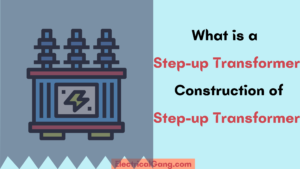
Hello friends, in today’s article we have seen what is a step-up transformer, why is it constructed and what is its working method and what are its advantages and disadvantages and what are its applications.
Introduction:
A transformer is a static electrical device used to transfer energy electrically between two circuits. The main function of a transformer is to convert from one voltage to another voltage. Inside the transformer, there are no moving parts like a motor and it works on the principle of magnetic induction.
Transformers are designed in two main ways: step up and step down. The main function of the step-up transformer is to increase the given voltage while the main function of the step-down transformer is to decrease the voltage. The rating of the transformer is in KVA, VA, MVA, and such requirements can be made accordingly.
Suggested Read: Advantages of High Transmission Voltage
What is a Step-up Transformer?

Step-up Transformer is known as a step-up transformer to increase the output voltage without any difference while maintaining the current. Transformers are mainly used for power transmission and power plants. It has two main windings, a primary winding, and a secondary winding. It has more turns in the secondary winding than in the primary winding.
Construction of Step-up Transformer:
It is mainly made up of 2 parts one is the core and the other is the winding.
The Core:
The design of the transformer core is made using highly impermeable materials. This material allows the magnetic flux to flow with less damage. The core material contains a higher permeability than the adjacent air.
So that this material will limit the magnetic line inside the main material. In this way, the efficiency of the transformer can be increased by minimizing the damage.
The magnetic core allows the magnetic flux to flow inside it and leads to damage to the roots such as eddy current loss due to hysteresis. Therefore, hysteresis and low-coactivity materials are chosen to make magnetic cores similar to ferrite or silicon steel.
The transformer core is laminated to keep the eddy current to a minimum. This can prevent core heating. When the core heats up, there is a significant loss of electrical energy. And the efficiency of the transformer may be reduced.
Suggested Read : What is a Step-Down Transformer? | The Definitive Guide
The Winding:
The windings in the step-up transformer will help transmit the injured current to the transformer. These windings are specially designed to keep the transformer cool and to withstand testing and operational conditions.
The wire gauge thickness is used in the primary winding side and its turns are less than in the secondary winding. Similarly, a thin gauge is used in the secondary winding and its turns are more than the primary winding.
It is designed in such a way that the primary winding can carry less power voltage than the secondary winding. The material used in the transformer winding is usually copper or aluminum.
Aluminum is cheaper than copper but the life of the transformer can be extended by using copper. There are various types of laminations available in transformers that can reduce the eddy currents like EE type and EI type.
Working of Step-Up Transformer:
The step-up is as per the diagram of the transformer. This figure shows the input and output voltages using E1 and E2. The turns of the windings of the transformer are T1 and T2. Here the input winding is primary while the output is secondary.

The output voltage is higher than the given voltage because the turns of the primary winding are less than those of the secondary winding. Once the alternating current flows into the transformer then the current flows in one direction and stops and turns the direction to flow in the other direction.
The current will create a magnetic field in the field of the current winding. The direction of the magnetic poles also changes once the current flow changes its direction. The voltage is induced in the windings by a magnetic field. Similarly, the voltage will be induced inside a dynamic coil, when it is located in a dynamic magnetic field, known as mutual induction.
Therefore, AC in the primary winding generates a dynamic magnetic field so that voltage can be induced in the secondary winding. The main relationship between the number of turns in each coil and the voltage can be given using this step-up transformer formula.
E2/E1 = T2/T1
Where ‘E2’ is the voltage across the secondary coil.
The voltage ‘E1’ is the primary coil.
‘T2’ turns on the secondary coil.
‘T1’ turns on the primary coil.
Suggested Read: What is a Potential Transformer | Construction of Potential Transformer
Advantages of Step-up Transformer:
The advantages of a Step-up Transformer are as follows:
- This is used for residential and commercial space.
- To work constantly.
- Power transmitter.
- Quick start.
- Maintenance.
- Efficiency.
Disadvantages of Step-up Transformer:
The disadvantages of Step-up Transformer are as follows:
- It needs a cooling system due to overheating.
- Works only for AC current.
- The size of these transformers is very large.
Applications of Step-up Transformer:
The Application of the step-up transformer is as follows:
- This is used for the distribution of electricity.
- This is used to increase the voltage in the transmission line which is generated by the alternator
- These transformers are also used to make electric motor runs, X-ray machines, microwave ovens, etc.
- Such transformers are also used in electronic equipment such as inverters & stabilizers to stabilize the voltage from low to high.
- It is used to propel electrical and electronic devices.
Most Commonly Asked Questions:

What is a step-up transformer used for?
The step-up transformer in the national grid is used to increase the voltage and reduce the current. The voltage increases from the estimated 25,000 volts (V) to 400,000 V causing a decrease in current. Low current means that less energy is lost by heating the wire.
Is the step-up transformer AC or DC?
A boost converter (step-up converter) is a DC-to-DC power converter that has an output voltage higher than its input voltage.
Where is the step-up transformer?
Step-up Transformer is known as a step-up transformer to increase the output voltage without any difference while maintaining the current. Transformers are mainly used for power transmission and power plants. It has two main windings, a primary winding, and a secondary winding. It has more turns in the secondary winding than in the primary winding.
What is the difference between a step-up and a step-down transformer?
The main difference between a step-up and a step-down transformer is that the step-up transformer increases the output voltage, while the step-down transformer decreases the output voltage.
Like this post? Share it with your friends!
Suggested Read –
- What is a Signal Isolator? | A Complete Guide
- Highway/Street Light Names And Functions
- How to Fix YouTube TV Freezing Issues in Easy Steps
- How to Solve LG Content Store Not Working Problem?
- What is a Phototransistor | Construction of Phototransistor
- What is a Single Phase Transformer | Construction of Single Phase Transformer